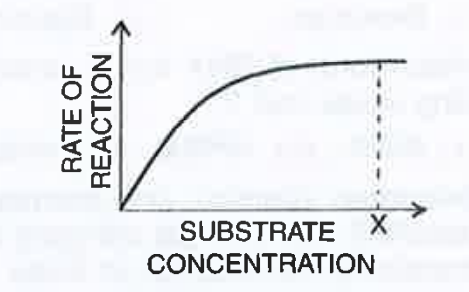Refer to the given graph showing relationship between temperature and enzyme action.
Select the correct statement regarding 'A' and 'B'.
(i) 'A' shows the rate at which reaction decreases due to denaturation of enzyme molecules.
(ii) 'B' shows rate at which reaction increases due to decreased kinetic energy of substrate.
(iii) As temperature rises, more and more enzyme molecules are denatured and 'A' appears to fall.
(iv) 'B' shows rate at which reaction increases due to increased kinetic energy of substrate and enzyme molecules.
 Solution in Odia
Solution in Odia
(i),(iii) and (iv)
(iii) only
(iii) and (iv) only
(i) and (ii) only
The correct Answer is:A
In this study, enzyme and substrate are treated with increasing temperature before thet are mixed and the rate of reaction determined. Enzymes are mostly proteinaceous molecules. Proteins are denaturated by heat, and the rate of denaturation increases and becomes significant at higher temperatures. When enzyme is mixed with substrate, with increase in temperature the rate of reaction increases as there increased kinetic energy of both substrate and enzyme molecules leading to more rapid movement and their collisions. However, with increase in temperature denaturation of enzyme occurs which is in irreversible destruction, eventually destroying the active sites. As a result there is an apparent optimum temperature for the action of an enzyme due to dual effect firstly, on the reaction and secondly, the stability of the enzyme protein.
Similar Questions
[A] : The rate of an enzymic catalysed reaction is increased from 1 to 3 times for every 10∘ rise in temperature .
[R] : There is an optimum temperature for every enzyme beyond which there is no rise and may be denatured after more increases .
View SolutionThe following graph depicts the effect of temperature on the activity of the two enzymes A and B that catalyze the same reaction. Choose the correct statement(s) for these results.

A. The rate of reaction in each case increases with increase in temperature and declines at higher temperatures due to denaturation of the enzyme.
B. Both the enzymes A and B are thermolabile.
C. At higher temperature, the reactants become highly energized and fail to interact with the active site, thus decreasing the rate of reaction.
D. The enzyme A is from a mesophilic organism, whereas the enzyme B is from a thermophilic organism.
View SolutionEnzymes get denatured (killed) due to
View SolutionThe given graph is showing the relationship between the rate of enzyme reaction and concentration of substrate. At concentration of substrate greater than X, the

View Solution[A] : The rate of an enzymic catalysed reaction is increased from 1 to 3 times for every 10∘ rise in temperature .
[R] : There is an optimum temperature for every enzyme beyond which there is no rise and may be denatured after more increases .
View SolutionEnzymes get denatured (killed) due to
View SolutionThe given graph is showing the relationship between the rate of enzyme reaction and concentration of substrate. At concentration of substrate greater than X, the
View Solution[A] : The rate of an enzymic catalysed reaction is increased from 1 to 3 times for every 10∘ rise in temperature .
[R] : There is an optimum temperature for every enzyme beyond which there is no rise and may be denatured after more increases .
View Solution
